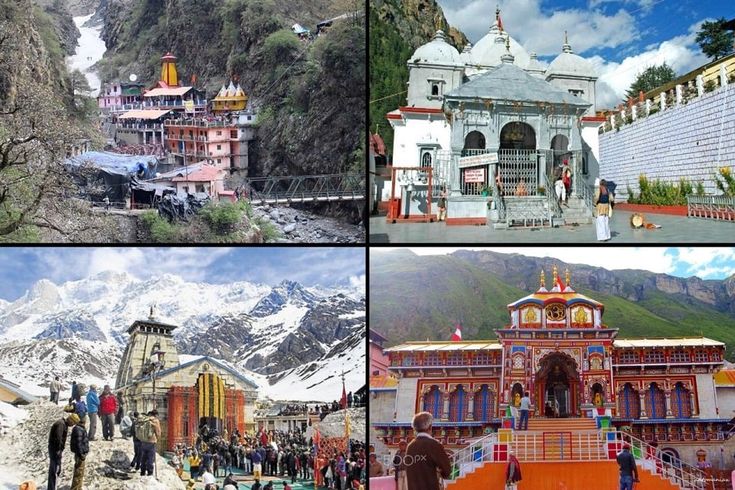Char Dham Yatra – Everything You Need to Know
Char Dham Yatra is one of the holiest pilgrimages for Hindus all over the world. This journey on the Garhwal hills of Devbhoomi Uttarakhand has been going on since the ancient ages. This pilgrimage takes you across 4 holy Dhams of Kedarnath, Badrinath, Gangotri and Yamunotri.
The history of these temples, legends and myths associated with them and the fact that it has been worshipped over centuries and millenniums makes this Yatra truly one of a kind.
Surrounded by impeccable natural beauty of the untouched Himalayas, the Char Dham Yatra has come a long way from being a pilgrimage impossible to complete to a dream come true. Sure it has become much easier to reach but being located in remote locations does require some amount of planning and information.
Let’s start with getting to know a little bit about the temples of Char Dham Yatra
History of Kedarnath
The original building date of the temple is unknown. However, one of the most widely accepted theories is that it had been built by the Pandava brothers. After the Mahabharat war, following the advice given by their priest to them they went to look for Lord Shiva during their visit to Kedarnath when they were on a lookout for Lord Shiva asking for forgiveness for committing the sin of Brahmahatya. When they reached Kedarnath Lord Shiva hid from them in the form of a bull but was discovered by Bheem who then caught hold of his tail when he was trying to escape through the ground. Although the lord escaped they decided to make the temple here to perform puja and Havan rituals to him.
Visit from Adi Shankaracharya – It was during the 7th or 8th century when Adi Shankara reached Kedarnath and decided to reopen it for pilgrimage purposes. He placed the holy Shivling in the form of a unique glistening pyramidal stone and began worshipping it there. Adi Shankara took his last breath in Kedarnath at the age of 35.
History of Badrinath
Badrinath is one of the most popular temples among the Char Dham temples which is dedicated to Lord Vishnu who is worshipped as Bari Narayan there. Located on the banks of the holy river of Alaknanda, it is surrounded by natural hot water springs. There are several historical and religious significance associated with this iconic temple shrine. Also known as Badri Kshetra, it was here that Lord Badri was intensely meditating without a care for the weather. When the weather started getting worse it was goddess Lakshmi who turned into a tree to protect the lord from the harsh climatic elements. The temple now stands on the place where Lord Vishnu had meditated.
The original idol that is kept inside the temple was found in a cave near Tapt Kund but was moved to its current location by the Garhwal king to make it more accessible for pilgrims to offer their prayers.
Visit from Adi Shankaracharya – While on the mission to revive a feeling of oneness among the Hindus of the world Adi Shankara visited Badrinath Dham during the 8th century. He negotiated with the Garhwal king and drove the Buddhists out from the temple to reopen it as a place of Vishnu worship.
History of Gangotri
Gangotri temple is one of the prettiest temples in all of Char Dham temples. Located amidst the refreshing beauty of the Gangotri national park and surrounded by tall trees and green hills, this is one temple that you should go to if you love natural beauty and peace. The history of Gangotri temple is very interesting. It dates back to the time when there was no river Ganga flowing on the earthly realm, it was only present in the heavenly abode. King Bhagirath had gone to the Himalayas to perform penance to goddess Ganga and request her to descend down to the earth and cleanse the departed souls of his forefathers. Pleased with his penance the goddess graced the earth with her presence through lord Shiva’s dreadlocks.
Visit from Adi Shankaracharya – Adi Shankara visited Gangotri during the 8th century and recognized that it was this place that was the original starting Point of Ganga River. The current temple was built by the queen of Jaipur in complete white marble.
History of Yamunotri
As the name suggests this temple marks the starting point of the Yamuna River whose source is traced back to the unreachable spot of Bandarpunch Glacier. Traditionally Yamunotri temple is the starting point of this clockwise holy journey. The date of this temple’s establishment can be traced back to the time of Sage Asit Muni, who as a part of his everyday ritual used to bathe in both Ganga and Yamuna River. As he grew older and unable to carry out this ritual, the Yamuna River gradually appeared and made its way through its current course so that the sage is able to do this without any problem. The king of Tehri took it upon him to build the temple structure during the 18th century and later on it was rebuilt by maharani of Jaipur (who had also built Gangotri temple).
Visit from Adi Shankaracharya – Adi Shankara had found the ammonite stone by the river water and being a unique sign of the goddess, he decided to enshrine it as the main deity of the temple.
History of Char Dham Yatra
Literally translating into the journey to the 4 holy abodes, is one of the most notable journeys that every Hindu plans on undertaking at least once in a lifetime. It is said that making this journey will free you from the karmic cycle of birth and rebirth which also means attaining moksha. Char Dham Yatra was set up and started by the great sage, saint and philosopher Adi Shankara who is also the propagator of the Advaita Vedanta philosophy of Hinduism. Over his lifetime he is credited with establishing numerous Mathhs, shrines, temples and pilgrimages in order to reignite the feeling of oneness and brotherhood among the citizens of India, that had been disturbed due to the constant attacks by foreign invaders, empires and rulers. He established the pilgrimage of Kedarnath, Badrinath, Gangotri and Yamunotri in an attempt to make Indians leave their houses and mingle with each other on the way.
How to Reach Char Dham
With wide scale development and construction of roads, the modes of transportation to reach these 4 temples have improved. Here are some ways you can choose to reach these temples with complete ease and comfort:
Char Dham Yatra By Helicopter – Helicopter is one of the easiest, most comfortable and quickest ways of completing this holy journey. For completing the 4 Dham Yatra a helicopter journey would only take 2 to 5 days. This will also include a VIP Darshan pass that will allow you to jump the long waiting lines and offer your prayer with ease. The Chardham Yatra by helicopter package will begin from the Sahastradhara Helipad in Dehradun and will also drop you off at Dehradun. It is a good choice of getting to Char Dham if you are travelling with kids, infants, physically challenged people and senior citizens.
Char Dham Yatra By Road – The roads leading up to the Char Dham temples are well made and strong. This is also one of the most opted routes for a majority of pilgrims coming from various parts of the country. The road to Char Dham begins from the gateway to Chardham in Rishikesh. From here on there are buses, taxis and cabs on hire or even car renting options available for you to fit your budget and travel in the way which is best for you and your family. People also take their car if they have substantial experience on the hills driving and the route is impeccable.
Char Dham Yatra By Train – If you are looking for a budget travel experience to Chardham then getting to Rishikesh from train is a good option. Rishikesh or Dehradun railway station are 2 of the nearest railway stations connecting the Char Dham Yatra to the rest of India. After Deboarding at the Rishikesh railway station you can choose the mode you will be choosing to further complete your journey ranging from shared jeeps, cabs and buses to renting cars and even bikes!
Travel Tips for Char Dham
Getting to Char Dham temples is not an easy job. It needs active preparation and planning before actually setting out on this soulful journey. Here are some travel tips that will help you get to the Char Dham sites:
- The temples open their doors for just 6 months a year starting from late April to early May and then stays open till late October or early November. Be sure to book your tickets a year prior to your date of travel and only plan your trip during the sunny season when it’s absolutely safe to get around.
- Pack some good quality of woolen and warm clothing and accessories so that you are bundled up in warm clothing since the weather changes here are pretty unpredictable.
- Carry the copies of your ID proof like an Aadhaar Card or driver’s license since you never know when you will be asked for it.
- Also be sure to always carry your Yatri registration card as you may be asked for it during certain police checkpoints and travelling without it is not permitted.
- If going for Char Dham Yatra By Helicopter then remember to always be on time as written on your itineraries since the chopper has the authority to reject their services to anyone they deem unfit for travel or even if you are late or a no show.









